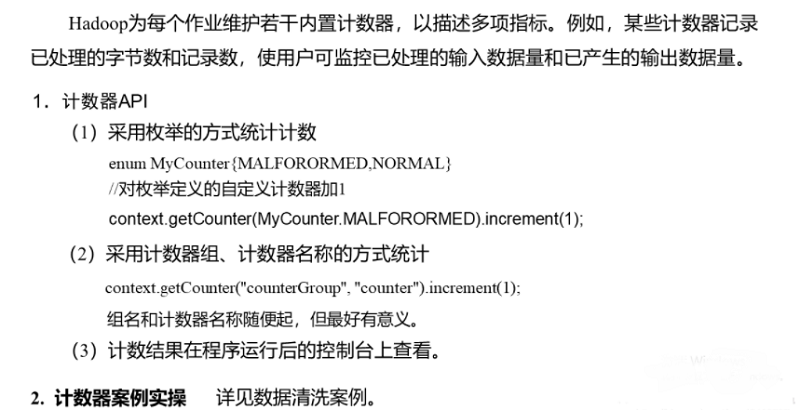
數據清洗(ETL)
在運行核心業務MapReduce程序之前,往往要先對數據進行清洗,清理掉不符合用戶要求的數據。清理的過程往往只需要運行Mapper程序,不需要運行Reduce程序。
1.需求
去除日志中字段長度小于等于11的日志。
(1)輸入數據
web.log
(2)期望輸出數據
每行字段長度都大于11
2.需求分析
需要在Map階段對輸入的數據根據規則進行過濾清洗。
3.實現代碼
(1)編寫LogMapper類
package com.atguigu.mapreduce.weblog;
import java.io.IOException;
import org.apache.hadoop.io.LongWritable;
import org.apache.hadoop.io.NullWritable;
import org.apache.hadoop.io.Text;
import org.apache.hadoop.mapreduce.Mapper;
public class LogMapper extends Mapper<LongWritable, Text, Text, NullWritable>{
Text k = new Text();
@Override
protected void map(LongWritable key, Text value, Context context) throws IOException, InterruptedException {
// 1 獲取1行數據
String line = value.toString();
// 2 解析日志
boolean result = parseLog(line,context);
// 3 日志不合法退出
if (!result) {
return;
}
// 4 設置key
k.set(line);
// 5 寫出數據
context.write(k, NullWritable.get());
}
// 2 解析日志
private boolean parseLog(String line, Context context) {
// 1 截取
String[] fields = line.split(" ");
// 2 日志長度大于11的為合法
if (fields.length > 11) {
// 系統計數器
context.getCounter("map", "true").increment(1);
return true;
}else {
context.getCounter("map", "false").increment(1);
return false;
}
}
}
(2)編寫LogDriver類
package com.atguigu.mapreduce.weblog;
import org.apache.hadoop.conf.Configuration;
import org.apache.hadoop.fs.Path;
import org.apache.hadoop.io.NullWritable;
import org.apache.hadoop.io.Text;
import org.apache.hadoop.mapreduce.Job;
import org.apache.hadoop.mapreduce.lib.input.FileInputFormat;
import org.apache.hadoop.mapreduce.lib.output.FileOutputFormat;
public class LogDriver {
public static void main(String[] args) throws Exception {
// 輸入輸出路徑需要根據自己電腦上實際的輸入輸出路徑設置
args = new String[] { "e:/input/inputlog", "e:/output1" };
// 1 獲取job信息
Configuration conf = new Configuration();
Job job = Job.getInstance(conf);
// 2 加載jar包
job.setJarByClass(LogDriver.class);
// 3 關聯map
job.setMapperClass(LogMapper.class);
// 4 設置最終輸出類型
job.setOutputKeyClass(Text.class);
job.setOutputValueClass(NullWritable.class);
// 設置reducetask個數為0
job.setNumReduceTasks(0);
// 5 設置輸入和輸出路徑
FileInputFormat.setInputPaths(job, new Path(args[0]));
FileOutputFormat.setOutputPath(job, new Path(args[1]));
// 6 提交
job.waitForCompletion(true);
}
}
總結
以上就是這篇文章的全部內容了,希望本文的內容對大家的學習或者工作具有一定的參考學習價值,謝謝大家對腳本之家的支持。如果你想了解更多相關內容請查看下面相關鏈接